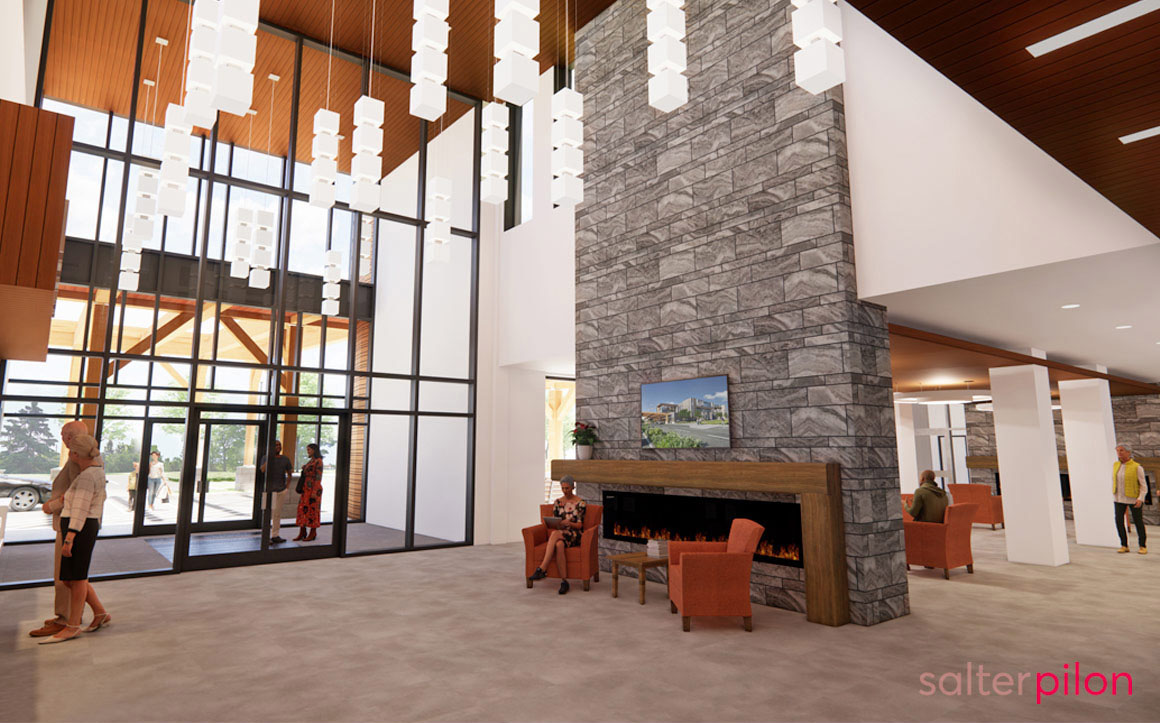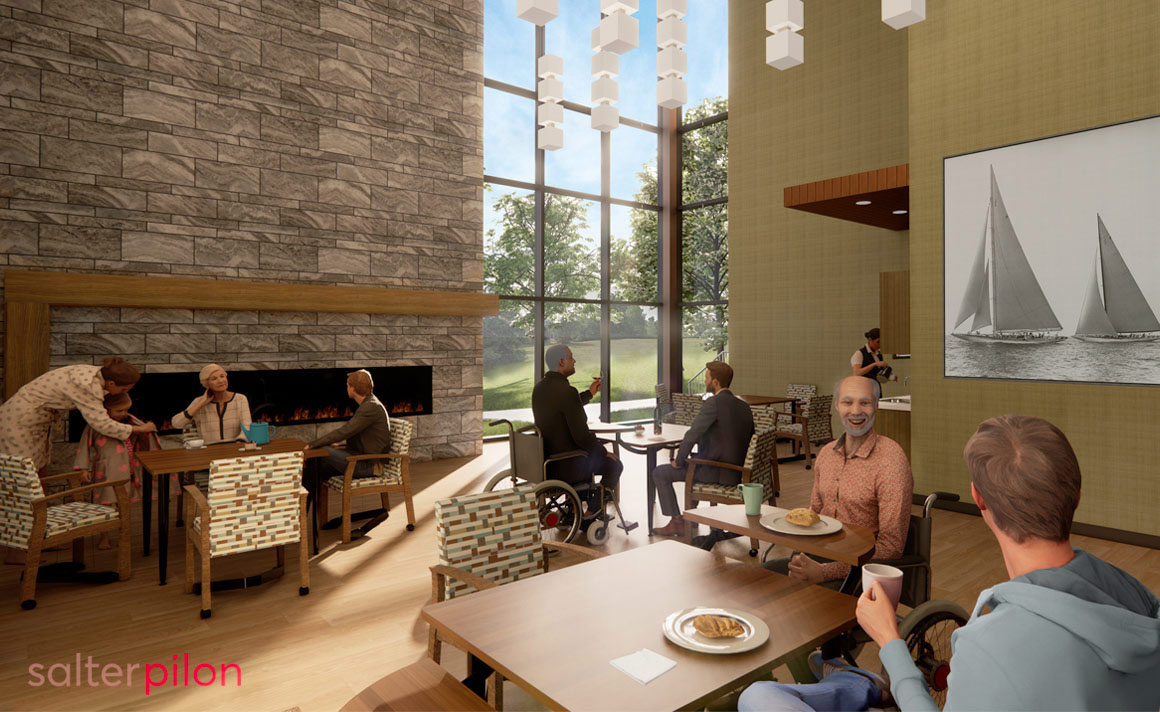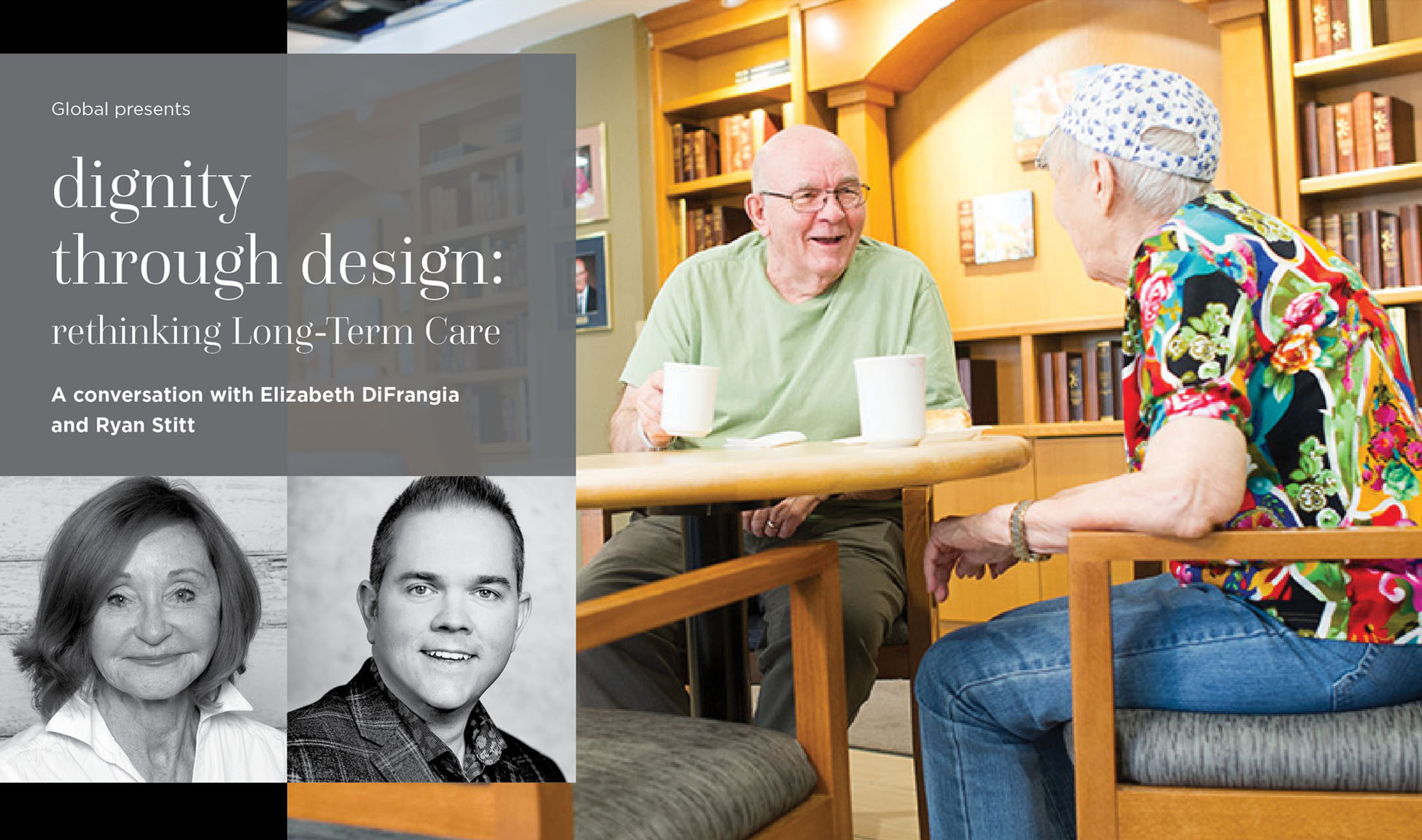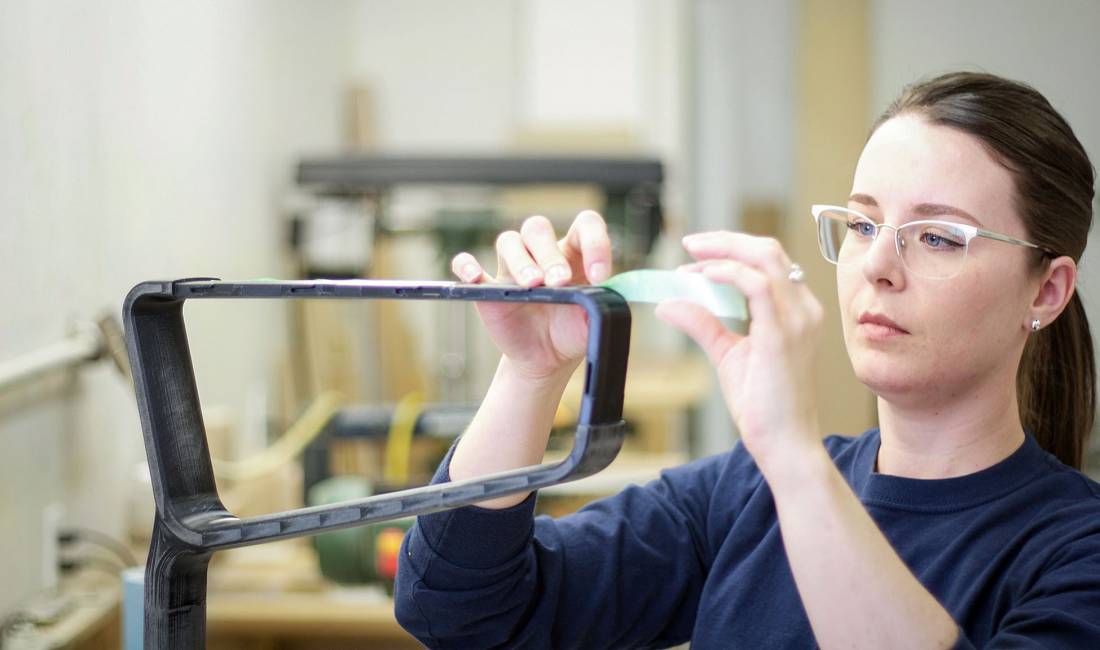How loneliness can be a greater danger than COVID-19 to our seniors over the long-term
Notes from the field | March 10, 2022
COVID-19 has underscored how important social connection is to the well-being of seniors. From lockdowns to restrictions on visitors and activities, long-term care (LTC) residents have endured strict infection and prevention control protocols to limit outbreaks. However, this protection has come at the cost of increased isolation and loneliness for many residents.
We spoke with Elizabeth DiFrangia, President at Rx Solutions, along with her colleague, Ryan Stitt, Associate at Salter Pilon Architecture Inc., about how COVID-19 has impacted residents’ emotional health, and got their insights on how we can combat the loneliness and isolation seniors can experience in LTC.
"I think connection means being valued—being seen. I think those things are essential to a person's health, whether they're seventy or sixty or whatever the case may be."
– Elizabeth DiFrangia
Q: How has COVID-19 compounded the isolation our seniors often experience in long-term care facilities?
The reality is, loneliness and isolation have always been an issue for seniors. In fact, one study reveals the prevalence of severe loneliness among older people living in care homes is at least double that of community-dwelling populations. Additionally, it demonstrated a nearly 50% increased risk of dementia and other serious medical conditions for those experiencing social isolation1.
So, we know that there is a direct correlation between loneliness and health and well-being2, a correlation starkly apparent during the pandemic.
In the name of IPAC (Infection Prevention and Control), residents were cut off from seeing their loved ones. Additionally, the moments of contact and connection they would have enjoyed at communal moments like dinner and group activity hours were suspended, while residents were confined to their rooms for extended periods of time during outbreaks.
As a result, many LTC facilities have experienced a deterioration in the general health of their residents.
 The atrium of Golden Plough Lodge being designed and developed by Salter Pilon Architecture and Rx Solutions. Welcoming elements like fireplaces and cozy lounge seating create inviting places for seniors to sit and feel connected to the comings and goings of people in the space.
The atrium of Golden Plough Lodge being designed and developed by Salter Pilon Architecture and Rx Solutions. Welcoming elements like fireplaces and cozy lounge seating create inviting places for seniors to sit and feel connected to the comings and goings of people in the space.
Q: As we understand the importance of social connection to overall health, how do we minimize loneliness so we can help deliver a better quality of life? From a design standpoint, how do we support connection, internally, within the building?
It’s important to understand that social isolation is a lack of social connections—so one can still feel lonely or isolated even in communal settings like LTC spaces, where there may be many residents.
That’s why we need to rethink how we design and allocate space within these homes, to ensure there are spaces where residents can see and be seen, or gather in different ways and with different groups to make critical social connections.
For example, often you’ll see lovely quiet rooms or private areas designed into the homes—places where residents can go to sit on their own or with visitors privately. And equally, you’ll find these spaces empty or barely used. Why? Residents don’t seek out privacy as much as they seek out life, the action, the bustle of a community.
 Yee Hong Peter K. Kwok Hospice designed by Rx Solutions and Larkin Architects. Comfortable seating vignettes encourage residents to socialize and connect with family and other residents.
Yee Hong Peter K. Kwok Hospice designed by Rx Solutions and Larkin Architects. Comfortable seating vignettes encourage residents to socialize and connect with family and other residents.
That’s why it’s more important and useful to create spaces that encourage socialization and connection than ones that focus on the individual.
Let’s spend more time creating ‘front porches’ at the lobby of homes and reception areas where residents can watch the world go by. Residents naturally gravitate to these spots, so why not accommodate that need for connection? Design seating vignettes in the front lobby that support connection and comfort whether they are mobile or in a wheelchair.
"A senior doesn't want to go into a little sitting room all by themselves. They want to socialize as much as possible . . . having opportunities to connect with people within their own resident home areas, but also out in the community within the facility."
– Elizabeth DiFrangia
Simple touches, like spacing out the seating, ensures wheelchair users are welcome. Also, the addition of items like planter boxes not only helps divide the space, but also blocks the draft from the front doors, making it comfortable to stay for a while. While these details can seem small, they are transformative in terms of resident experience.
Overall, we shouldn’t be too rigid with public amenities—any space should be flexible enough to respond to the ebb and flow of the residents.
 Integrating multi-purpose rooms in the facility offer places for residents and the community to engage and connect through facilitated activities. Golden Plough Lodge.
Integrating multi-purpose rooms in the facility offer places for residents and the community to engage and connect through facilitated activities. Golden Plough Lodge.
We should also consider the social importance of spaces like tuck shops, cafés or libraries. Tuck shops are not only a place for residents to purchase treats for themselves, but also they create an opportunity to converse with neighbors. And the hours of operation for cafés or libraries need to be aligned to coincide with the activities for the residents and the staff who support them.
Q: When combatting isolation, what role can the community play?
Well, maybe a better question is, “What role can the resident play in the community?” If we flip that question then we unlock considerable potential for the residences and the people who live within them.
We believe a LTC residence can serve a dual purpose in the community. Not only can it serve the residents, but it can serve the community as a whole by drawing in the neighborhood and connecting residents back to it in an authentic way. We shouldn’t be designing for residents in an isolated building.
A great example of this is the Golden Plough Lodge, a project that Ryan is working on at the moment. It’s an LTC facility that will also house the Northumberland County Archives & Museum. Bringing them together creates a vital resource to the community, attracting visitors and also providing a strong connection to the identity of the county.

Another example is Villa Columbo, a not-for-profit LTC home.
Here we have a facility that caters to the cultural needs of the Italian community it is located in. Connected to the Italian cultural community center and daycare, residents are able to remain connected to their heritage and community. This is supported by encouraging residents to go to public events like gallery openings and interacting with children in the daycare. Every spring, residents are paired with a number of children with whom they plant a vegetable garden, a perfect example of a relationship where both the community and the residents benefit.
Q: What do you see as the future for LTC?
As we build more facilities to meet the growing needs of seniors, we think the best approach is to build senior living communities of care where everything is fully integrated into a campus of care.
Salter Pilon is currently working with Simcoe County on the redevelopment of their new Simcoe Village. The project will be developed as a campus, encompassing a full range of senior care living. This includes a range of living options from life lease suites, market rental apartments, retirement living, life lease garden homes, rental town homes, affordable housing for seniors, supportive housing, and co-housing rentals to LTC, all within one campus.
What’s great about this, is that no matter what your health status is, you can continue to be accommodated within the same community and maintain the social relationships and connections.
 Family café, Golden Plough Lodge. A campus approach accommodates places for a range of people – from residents and their families to the larger community.
Family café, Golden Plough Lodge. A campus approach accommodates places for a range of people – from residents and their families to the larger community.
Taking a campus approach has allowed us to leverage the size of the campus (nearly 439,000 square feet) to bring in retail amenities like restaurants and pubs that are linked by a shared community hub. Additionally, dedicated medical/health services like orthopedics, doctors’ offices, auditoriums and places of worship provide everything a resident may need in one place. This is key for seniors who are less mobile, or do not drive anymore.
Finally, layering in elements like outdoor recreation options and activity programs that are open to anyone in the larger community, make the campus a destination for both those inside and outside the campus, strengthening the ties and connections between groups. By bringing everything together, we enable the personalization of care in a setting that supports community.
This is what we believe the future of LTC to be—tailored care that helps seniors maintain their vital social connections.
1Victor C.R. Loneliness in care homes: A neglected area of research? Aging Health. 2012;8:637–646.
2Loneliness and Social Isolation Linked to Serious Health Conditions. (April 29, 2021)
Centers for Disease Control and Prevention.
![]()
Elizabeth DiFrangia
President, Rx Solutions
Elizabeth has 30 years of experience managing a team of planners/designers in supporting clients, contractors and architects in all aspects of their needs (regarding Medical Equipment Planning and Procurement as well as Furniture/Finishes needs for many of healthcare projects throughout Canada). In 2017, Elizabeth created Rx Solutions to support the ongoing special needs for her clients.
Rx Solutions are constantly educating themselves about the challenging needs of their clients now and in the future.
![]()
Ryan Stitt M.Arch OAA MRAIC
Associate, Salter Pilon Architecture
As a Senior Associate at Salter Pilon Architecture, Ryan has a leading design and management role. Ryan has been and is currently involved in numerous long-term care, senior housing and continuing care projects.
Along with these projects Ryan works on education, first responder, civic, housing and healthcare projects. This diverse experience allows him to continue to build a strong knowledge of varied building types, clients, functional programs and design initiatives. His abilities with client interaction and consultant coordination further enhance his project management skills, proving him to be a natural team leader.
Ryan demonstrates the ambition to constantly learn and evolve as a member of Salter Pilon’s team. His valued contributions to all projects in which he is involved reinforce the positive impacts that these projects have on the building users and the communities in which they reside.
Enjoy this article? Don't forget to share.






